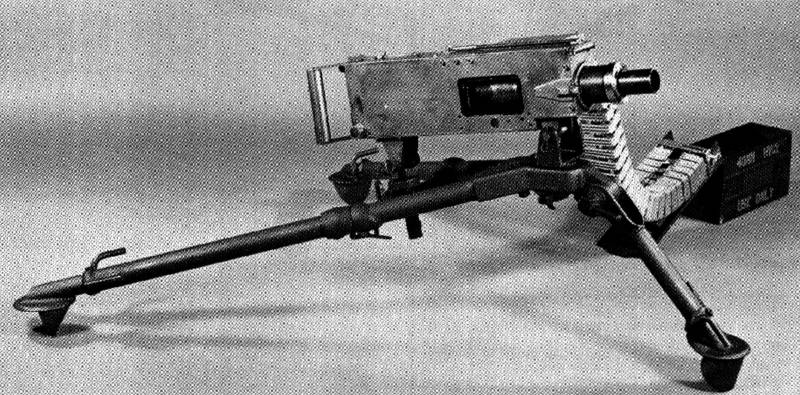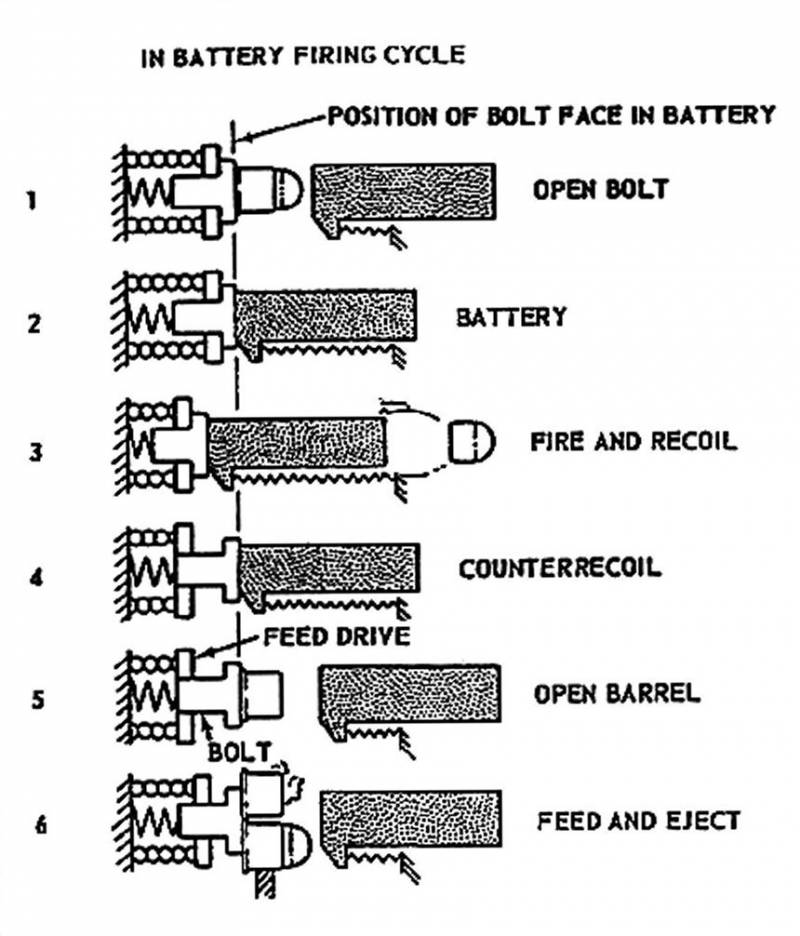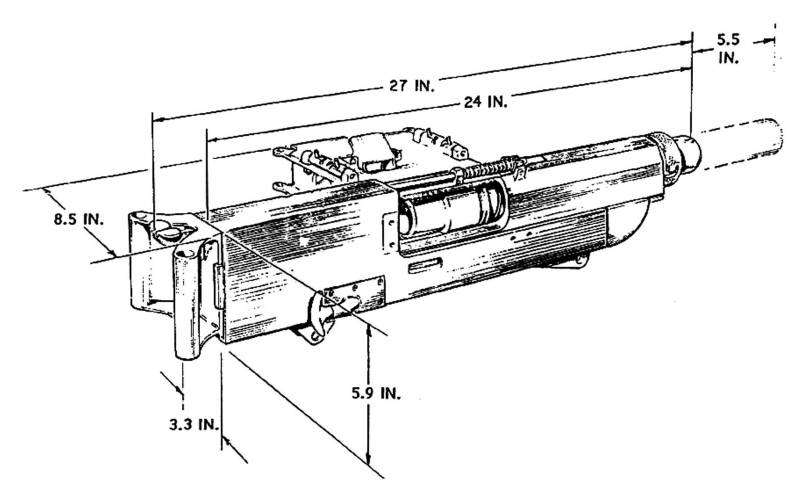Experimental automatic grenade launcher CROW (USA)
The future project CROW was launched in 1969 year and was originally created in an initiative order. His goal was to implement a new concept that allowed creating an automatic grenade launcher with noticeable advantages over existing samples. One of the main problems of the early weapons of this class was excessive recoil, which led to strong shaking and worsened the accuracy of the fire. Through the use of some special ideas and solutions, it was possible to reduce recoil, and with it the vibration of the weapon, which had a negative effect on the results of the shooting.
The new proposal was able to quickly interest a potential customer, and from a certain time all the work was carried out under the supervision of the relevant directorates of the American army. In accordance with the signed agreements, for the minimum possible time Filco-Ford was to carry out the design and submit to testing a prototype of a grenade launcher built on the basis of a new concept.
As conceived by the designers, for the correct distribution of forces and impulses acting on the weapon during firing, it was necessary to use automatic equipment with a moving bolt and barrel. Sequential movement of these parts in different directions was to "stretch" the recoil impulse over time and thereby reduce the impact on both the firing results and the arrow.
The presence of automation with a rollout of the trunk forward was reflected in the working title of the project. A promising grenade launcher was designated as CROW or Counter-Recoil Operation Weapon - “Weapons with automatic roll-over”. The weapon was not put into service, and therefore did not have an official army designation with the letters “M” or “XM”.
The elaboration of a new concept with the subsequent design and manufacture of a prototype took only a few months. Already in September, Philco-Ford sent 1969 the first CROW prototype to the shooting range. With the help of a number of different tests, it was planned to determine the actual characteristics of the resulting weapon, and in addition, to study its prospects in the context of rearming the army. Tests, as well as design, were conducted under the supervision and with the participation of the military.
It should be noted that from the point of view of the design and principles of operation of the automation, the CROW grenade launcher was a little like the Mk 20 Mod 0 product developed several years earlier. At the same time, the two samples had the most noticeable differences, both internal and external. In particular, the grenade launcher from "Filco-Ford" turned out to be a little less large, and also had a more utilitarian appearance, formed by several simplest units.
A new grenade launcher was equipped with a rectangular receiver, on which were mounted a movable barrel, a receiver of the tape and handles of control. On the front wall of the box was a short glass-trunk housing, through the opening of which the muzzle of the latter was pulled out. Front on the bottom of the box was provided for the installation of weapons on a standard machine for serial large-caliber machine guns. From the point of view of ergonomics, the CROW grenade launcher should have to some extent resemble the M2HB machine gun.
An experienced grenade launcher received a rectangular receiver with a flip top lid. On one side there was a window for feeding the tape, on the other - a window for ejecting liners and links. It is known about the development of an alternative version of the box, a different design and other contours. Such a unit should have a smaller height and a modified arrangement of moving parts of automation. In addition, the alternative box was different from the experienced great finesse lines.
The CROW product was completed with a rifled 40 mm caliber barrel, similar to those of other US automatic grenade launchers. Near the breech breech provided for emphasis to interact with the return spring. Unlike the already mentioned Mk 20 Mod 0, the CROW spring was placed under the barrel, and not put on it. During the reload cycle and shot, the barrel had to move back and forth. Automatics used a long roll out of the barrel - it moved to 5,5 inches (139,7 mm). The movable barrel was connected to the mechanism of ammunition. His reciprocating motion was transmitted to the tape with shots.
To prepare the weapon for firing, a mechanism was used by which the barrel was retracted to the extreme forward position, up to fixation with the sear. The cocking control was carried out using a T-shaped handle on the right side of the receiver.
The back of the receiver was given under the bolt and its return spring. The shutter itself was a metal block of rectangular cross section, interacting with a large return and a pair of compact buffer springs. Mirror shutter equipped with a fixed drummer. The gate also had the means to interact with the recharge mechanism.
The grenade launcher trigger was responsible for keeping the barrel in the extreme forward position and releasing it for firing. Fire control was carried out using the trigger button on the rear wall of the receiver. Next to it was a safety flag with which it was possible to block the descent. Also automatic weapons had the opportunity to choose the rate of fire - 140, 270 or 400 shots per minute.
The CROW project involved the use of ammunition of the type 40x46 mm with their feed with the help of a tape. The tape had to be transported in metal boxes and fed to the receiver of the weapon on its own or using a flexible hose. The grenade launcher was equipped with a removable magazine receiver, which could be installed on any side of the weapon, depending on its intended use. The drive mechanisms of the receiver was carried out from a moving barrel and bolt. The grenade launcher could pull the tape with an effort of 50 pounds (22,7 kg). In this parameter, CROW exceeded most of the grenade launchers of its time.
The prototype of the CROW automatic grenade launcher was intended only to test general ideas and solutions. For this reason, he did not receive any sights. During the first tests, it was planned to test the operation of the automation, and therefore it was supposed to shoot “in that direction”. However, in the future, the weapon could well get an open sight by the type of equipment of other grenade launchers of the time. The tests of the mechanisms could be followed by tests for accuracy and accuracy.
In the basic version of the new grenade launcher from Philco-Ford was a heavy weapon. It was proposed to install it on the U-shaped pin of a standard machine tripod for large-caliber machine guns. Under the rear of the receiver there was a mount for the screw mechanism of vertical pickup.
It was proposed to control the weapon with a pair of rear vertical arms of the "machine-gun" type. Between them there was a release button, and next to it was a fuse and a firing rate switch.
Ready CROW was not larger than other weapons in its class. The length of the weapon with the rearmost position of the barrel was 27 inches (686 mm), the width of the receiver taking into account the tape - 216 mm, height without machine - 5,9 inch (150 mm). Product weight - 35 pounds or 15,9 kg. According to calculations, according to its firing characteristics, the new grenade launcher, as a whole, had to correspond to another weapon of its class. At the same time, it was possible to count on obtaining increased accuracy and accuracy of fire, which should have been reduced by recoil.
Before firing, the grenade thrower had to pull the cocking handle, as a result of which the barrel was moved to the front position and squeezed its spring. Next, a grenade ribbon was placed in the receiver, and the weapon was ready to fire. Pressing the trigger released the barrel, and he under the action of the spring began to move backward. During the movement, the breech put on a grenade, and then pressed it to the gate. At the time of the impact of the breech of the breech and the bolt, the fixed drummer was pinching the cap. Shot occurred.
Under the effect of recoil, the bolt and barrel slightly shifted backward, compressing all available recoil springs. Then they straightened, sending the bolt and barrel forward. The shutter returned to its original position and stopped, and the barrel continued to move forward, squeezing its own spring. At the same time, the sleeve was removed, and the ammunition system brought a new shot to the gate. In the extreme forward position, the barrel was blocked by the sear, or it released it, allowing you to re-execute the shot.
In this automation, the shot occurred at the moment when the massive barrel was finishing backward movement and was hitting the shutter. The resulting pulses partially extinguished recoil. The movement of heavy parts after the shot also created new impulses, due to which the recoil compensation continued. It was assumed that all this will reduce the shaking of the weapon when shooting with obvious consequences for accuracy and accuracy.
In September, Filco-Ford sent for testing the first experienced CROW grenade launcher in an easel configuration. During these shooting it was planned to check the main characteristics of the weapon, as well as show it to potential customers. At the first test were invited representatives of the Pentagon.
An experienced grenade launcher without any delay was able to shoot the tape on the 50 grenade in one queue. It is worth recalling that serial products of other types used shorter ribbons - this was due to the characteristics of the ribbon feed systems. Shooting in short bursts with a different number of shots in each was also demonstrated. In addition, the military showed the possibility of changing the rate of fire and changing the side of the supply of ammunition. In general, the CROW product even in the form of the very first prototype showed quite high technical and operational characteristics, due to which it could be of interest to the army.
According to known data, the military became interested in the proposed model, although they expressed some wishes. To further improve the grenade launcher, certain improvements were needed both on the structure as a whole and on its individual elements. Apparently, it was the improvement of the grenade that led to the emergence of a new project with modified contours of the receiver and, probably, corrected internal equipment.
However, as far as is known, the updated and improved CROW automatic grenade launcher could not go on the test and existed only in the form of a set of drawings. The reasons for this are authentically unknown. It can be assumed that the revised version of the grenade launcher did not have decisive advantages over the basic version, and therefore the customer and the developer decided not to waste time on its assembly and testing. In addition, there was already an equally successful serial weapon, the replacement of which had no practical sense.
As a result, the CROW project, in which two versions of an automatic grenade launcher were developed, did not give real results in the context of rearming the army. The proposed weapon was considered solely as an experimental model for the search for new technologies, which in the long term could be used in the following projects. Putting into service, however, was not planned. Not so long ago, the US Army received a very successful grenade launcher Mk 19, and so far did not need to be replaced for it. It could be needed in the future, but at that time there was no need for it.
It can be assumed that the main achievements of the pilot project CROW could be used to create new automatic grenade launchers, but this did not happen. The product Mk 19, put into service in the late sixties, turned out to be very successful and, after several upgrades, remains in service until now. The question of replacing it began to be considered only in the recent past, and therefore the developments in the CROW, which appeared almost half a century ago, have not been applied.
In the late sixties, American industry developed several automatic grenade launchers. One of these projects left no real future for everyone else. The Mk 19 grenade launcher was so successful that it quickly drove all its predecessors out of the army, and also made other new projects unnecessary. One of his "victims" was the pilot project CROW. It could influence the further development of the whole direction, but story It turned out differently.
Based on:
https://warisboring.com/
https://bevfitchett.us/
Chinn GM The Machine Gun, Vol. Five. 1987.
Karpenko A.V. Automatic grenade launchers - weapons of the XX century. M .: Zeihgauz, 2007.



Information